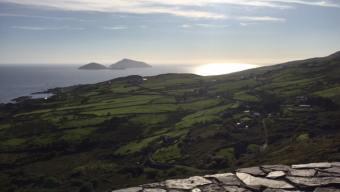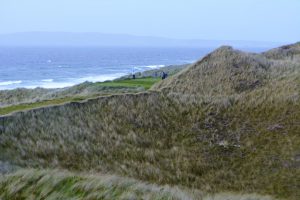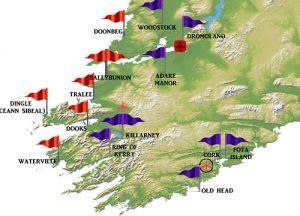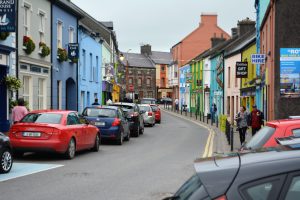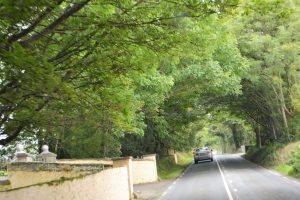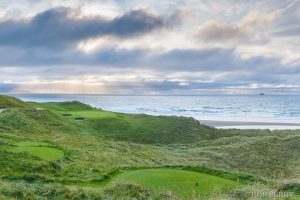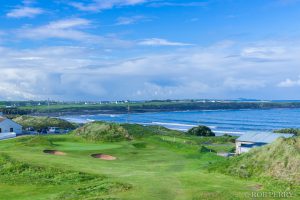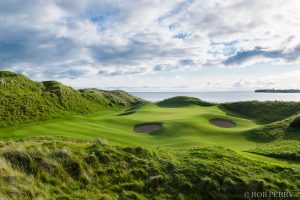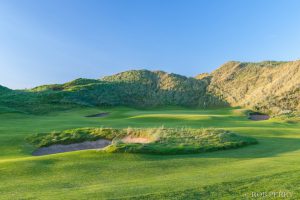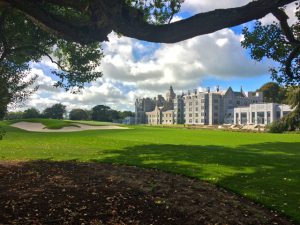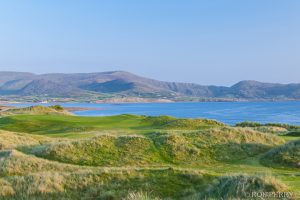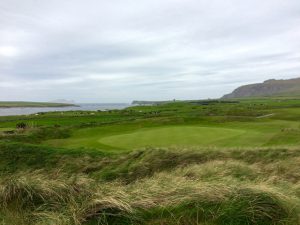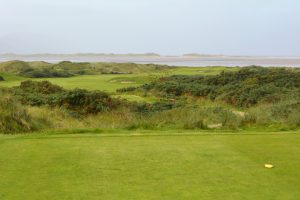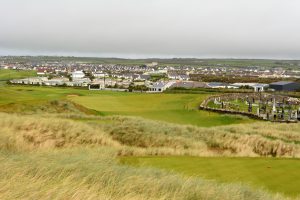Editor’s Note: During this difficult time dealing with the Coronavirus outbreak, leaving golf writers nothing to write about, we decided to revisit some of the places we have gone over the years. Today, we begin an 11-part series on the wonderful golf paradise of Ireland.
(First of an 11-part series)
WATERVILLE, County Kerry, Ireland — They are seemingly in every little village and every little town across in Ireland, north, south, east and west, yet, in relation to the rest of the world, they are a fragile few.
They are links golf courses, a relatively rare style of play outside the British Isles, but the world’s oldest variety. They evolved five centuries ago in Scotland, as aristocratic men would hit feathery balls with rough hew hickory sticks to distant targets across barren land not even suitable for farming. And the masters of the game were the ones who hit that crude ball less frequently.
Those Scotsmen set the standards for the number of holes (18) to set a score, the diameter of the hole (4.25 inches) as well as the rules of play, which, after a half-millennia, they’re still not quite done.
Over the centuries, equipment improved, the ball flew higher and rolled steadier, players became more efficient and courses more refined, such as they are on the Emerald Isle. Scotland may have started all this but Ireland, with a surge of courses in the late 19th Century, has taken links to another dimension.
“Our courses are full of features. Scottish courses are flat,” said Brian O’Callaghan, head professional at Ballybunion, consistently rated as one of the great links courses in the world. “They have to add features to refine golf courses. They built upward.”
The Irish features were already there and already up, the dunes, the burns, the gorse and the heavy grasses. They are the natural features God placed in the way just to preserve the game’s integrity.
Then there are the elements beyond control yet essential to links play, the mist, the fog, the low clouds, the moving sheets of rain and the winds that can scatter golf balls to an oblivion of fescue. They give the Irish courses a mystic feel, although if your drive just sailed over an ocean edge you’re more pessimistic.
Links generally do not fit the American eye. In the States, we like all things predictable, green manicured fairways, grass cut just so, fast putting surfaces and temperatures on par with our scores.
“We’re biased. We think it’s the greatest form of golf,” O’Callaghan said. “If you look at the new designs, a lot are using links style.”
Everything old is new again.
O’Callaghan said that Mike Kaiser, the innovative developer of the heralded links courses in Bandon, Ore., once asked him if there still was room for more links courses.
“I told him, ‘absolutely. They are a rare species,’ ” O’Callaghan said. “You can’t have enough of them. They’re wonderful. The one thing you can’t have enough of is links golf courses.”
They are so popular that, in fact, they are a significant contributor to the Irish economy, drawing millions of links-seeking American golfers willing to endure fierce winds and sideways rain for the pleasure of being in links heaven. There are plenty of terrific choices here, with more coming on line.
The American golfer, the course operators will tell you, comprised more than 70 percent of their business. Typically, they will visit for at least a week and play a different course every day. They also have a habit of returning, perhaps touring another linksy part of the country.
“They don’t travel from America to play one course,” Dooks general manager Maurice O’Meara said.
The Isle has developed a remarkable number of world-class courses, including what many consider to be the world’s greatest course, links or otherwise, Royal County Downs in Northern Ireland. That area also has other top courses such as Royal Portrush and Castlerock.
To the east near Dublin, the K Club, Portmarnock and Royal Dublin stand out. In northwest Ireland, Carne, Ballyliffin and County Sligo are heralded.
However, the most abundant and most noted courses are west/southwest, Ballybunion, Lahinch, Doonbeg, Waterville, Tralee. Touring groups use sparkling towns such as Killarney, Adare, Dingle, Lahinch or Waterville as base of operations then drive narrow country roads along the Ring of Kerry or Dingle Peninsula to play their prepared links circuit.
That’s where our tour centered, southwest Ireland, on the edge of the Atlantic. This is the first of an 11-part series on: Mystic Links of Ireland.
Four for the road (holes)
Four journalists took part in the 10-day trip. It was my second trip to the Emerald Isle but first to play golf. It was a special tour, dazzling courses, affable people, ancient sights and new experiences. It was pleasure/business trip, as this series on Golferswest.com offer insights, information and suggestions for those willing to embark on an Irish mystic tour.
The others on the trip were Blaine Newnham, the former Seattle Times sports columnist who has written about golf his entire career and Rob Perry, one of the country’s best golf-course photographers, provided many of the pictures that will accompany our stories.
Our trip organizer, Tom Cade, filled out the foursome. He’s the senior director of communications and editor of Pacific Northwest Golfer magazine. Cade’s significant other, Susan Terry, also joined us in a non-golfing role. She was our technology advisor, travel scout and thoughtful conversationalist. All live in the Seattle area.
Our trip was arranged through Tourism Ireland, which set up the courses, interviews, lodging and tee times. The focus was southwest Ireland, as we spent a couple nights in Lahinch, on the west coast not far from the breathtaking Cliffs of Moher. For the rest of the trip, we stayed at a B&B in Waterville, a picturesque village along the Ring of Kerry.
It was a fine mix of players, as Blaine and I were the older folks, carrying mid-teen (or higher) indexes and playing one or two tees forward. Tom and Rob are single-digit players who played one tee back.
It was also a good mix of courses provided by Tourism Ireland. Some were established, well-known courses, perhaps a price-point reach for some, and some were low-profile neighborhood circuits that are affordable and equally pleasurable to play.
While I won’t detail how I did hole-by-hole, course-by-course — no one really cares — I’ll offer occasional suggestions, perhaps cautionary tales, in this series on how (not) to play certain holes as well as some personal impressions and reflections that may bleed into the copy.
These are the courses we played, with my scores in parentheses just to give you an idea of my “skill” level and how it relates to others. (No excuses, but it is hard adjusting to the 45-mph winds, deep fescue and the slow pace of the greens). We played Lahinch (99), Trump Doonbeg (96), Waterville (89), Dingle (94), Tralee (89), Dooks (93) and Ballybunion (89).
We also partially played one terrific new course Hogs Head, on a hill above Waterville. We played just 12 holes – in a cold driving rainstorm — because the course is not quite completed. The operators did not want anything written yet or photos taken because they don’t believe it’s ready for public consumption. It will be soon.
I can tell you that Hogs Head, a Robert Trent Jones, Sr. design, is going to be stunning, with a classy clubhouse and a challenging layout. It’ll be a must-play headlands (links’ cousin) addition for Americans following the SW Ireland circuit.
We also toured but didn’t play two other courses, diametrically opposed. Spanish Point is a humble nine-hole layout on the coast halfway between Lahinch and Doonbeg (not even listed on our above map). It looks quite inviting and a absolute bargain to play.
The other was the elegant and elite Adare Manor Golf Club that may one day be ranked among the best in the world. It’s a parkland course re-designed by Tom Fazio (Robert Trent Jones, Sr. was original designer) that is targeting the 2026 Ryder Cup. It’s richly magnificent, some say, “The Augusta of Ireland.”
The definition of links also needs to be addressed at the start. We had some debate over all the elements that should be included to be considered links. But honestly, not all have it all, some more, some less, some with, some without. It’s not necessarily so strictly defined.
Links, coming from the Scottish tradition, connects the sea to the land. They are usually on gradual sloping, non-arable lands up from the water, generally free of trees and full of thick fescue grasses or brush, dunes, uneven lies, and sandy-soil, hard-and-fast, tight-lie surfaces.
However, there are plenty of non-coastal links courses that do not touch any water. Some have few or no dunes, some have low trees. Some have no heavy rough, some have vast inaccessible fescue patches. All of them, or at least the ones ranked among the best, should have weather. By weather, that means playing through heavy showers and ridiculously strong wind off large bodies of water. Watching the Open Championship just about every year and you get the picture.
“We could have the four seasons in an hour,” said Brian Shaw, head professional at Trump Doonbeg. That is the rule, not the exception. Those coming here must accept it as part of the deal. Weather wimps need not apply.
You can start your ball off one direction and invariably it will finish somewhere else. Links golf forces another style of play, low drives and approach shots. You have to master bump-and-run techniques. You even can putt from the fairway to the greens, as much as a football field away. And the greens are slower because the winds would blow balls off if the grass was cut too low.
Having played some of the great and historical Scottish courses a few years back with my son Bobby, Ireland offers a richer links contrast. What Ireland may lack in history, it has drama in abundance. Oh, the drama – the impenetrable dunes, the near inescapable pot bunkers, the elevated tees and greens, the gorse, mighty winds and mystical mist. It’s all there. It’s why were there.
Towns and taverns
One of the great pleasures of touring Ireland, or any country, is the energy and the vibe you feel as you visit the towns and villages. Those quaint and picturesque villages are the strength and the lure of the Emerald Isle.
Generally in Ireland, all the towns’ taverns are the most inviting and well-appointed buildings. Of course, every single bar offers Guinness, the beloved Irish art-form brew that dates back 258 years. What I have learned is that you can judge a tavern by the way it pours the bubbly suds. If there are a couple three-quarter-filled glasses of Guinness near the draft station as you walk in, that’s a good sign. Then when you order, they top it off and deliver it quickly, instead of waiting forever for the foam to recede.
There are some fine Irish meals, thinking of wild boar on my previous visit (which may have been just a rough pig), but Ireland, much like English, is not known for its cuisine. There were a couple of unscientific studies that we conducted to determine where were the best fish-and-chips (in Lahinch) as well as the best seafood chowder.
For the chowder, it has to have a variety of fish and things in it, but no fillers like potatoes. It has to be tasteful, of course, and preferred thicky creamy. We sampled at least eight at various taverns, restaurants and golf courses and the winner was: Doonbeg. Hearty, fishy and full of stuff.
Some of the golf courses are so remote that they don’t have a substantial town center to speak of. Others are good size, closely connected to the courses and cater to the tourist flow.
We stayed or traveled through at least six city centers and all were a little different. All would be fine to spend extended time. The biggest city was Killarney, which, from a previous trip to Ireland, remains one of my favorite towns on the Emerald Isle, even the world. It has scores of traditional music taverns and is situated perfectly as a base for back-and-forth trips to Ballybunion, Tralee, Dingle, Dooks, Waterville and Hogs Head.
Dingle, on the western-most tip of Ireland, is much smaller, which makes it more personal and intimate. It’s a cozy town that could spend several days there. Great shops, restaurants and taverns. Adare, Lahinch and Kenmare are similar, varying a bit in size.
Waterville, with great views along the water, is a little quiet and limited but a village that one day you’d expect the city fathers will capitalize on its potential. With a new elegant course/hotel, Hogs Head, going in just a half mile up the road and the venerable Waterville course about two miles away, lively changes are inevitable.
Travel, apparel and left-hand thinking
The weather is the most significant element on a golf trip to Ireland, affecting how you pack, how you prepare and how you play.
Even if the forecast is for decent weather during your time, don’t believe it. It’s constantly changing. Prepare yourself for the worst and chances are you’ll get it.
Pack all the rain gear you can. Not just any slick material or water resistant. Preventative materials, Gore-Tex or something similar. There will be rounds where the rain will be constant, or heavy, or passing squalls. Or all of the above. You will get soaked at times but you have to continue. You planned enough, you paid enough, you’re on a prestigious course, quitting is not an option.
Bring along rain gloves or, as I did, plenty of your regular gloves in a plastic bag and rotate. And, by the way, whereever you stay, make sure there you have access to a washer AND dryer.
The rains can move in quickly so you really should have at least your rain pants on before you tee off.
We had three shirt-sleeve weather days and the rest rainy days. There was never a time when shorts were appropriate. In fact, I rarely saw anyone wearing shorts. They’re probably not even worth packing.
Also, virtually all airlines on international flights allow one free checked in bag, that’s your clubs. The second bag is $100. Ripofff! So it behooves you to have a small carry-on with a couple days worth of clothes along with your usual materials. Stuff the rest of your clothes in your golf carry-on. No added costs. And if you have that washer/dryer combo at your place, you can take about four full outfits and wash at the turn.
A good suggestion might to have a designated driver. That doesn’t mean the others can load up on the Guinness and Smithwick’s. It means one member of the group should be trusted to drive. When my son and I traveled through Scotland five years ago, I didn’t trust myself. The left-side roads, right-side steering and left-hand stick shift were more than I could confidently handle. I just feared that at some point I’d absentmindedly turn down the wrong side of the street and into trouble.
Rob and Tom were our designated drivers and adapted well to it. Irish roads are also quite different from Scotland. They are bumpy, hilly and incredibly narrow, at times squeezing from two tight lanes to one and a half. Without notice. Big tour buses and commercial trucks barrel down the road without flinching, slowing down, backing off or giving space. Close your eyes and leave the driving to a colleague.
Go raibh maith agat
That (above) is just a bunch of letters randomly lined up, right? Actually, it’s not. It means something in Gaelic, the ancient native language that goes back centuries and is still spoken and written prominently in three different regions in Ireland. At the Dingle Golf Links, all the signs are written in English and Gaelic side by side.
The language has had a revival in recent years. It is being taught in more school systems and has been designated as the official language of Ireland.
But it’s a language that has no basis of comparison to, say, the romance languages. It’s a challenge to spell it, pronounce it and understand it. It’s as if the Irish people devised a way to communicate among each other without grammar conventions, just to mess with and irritate their English overlords.
By the way, what does that Gaelic expression mean? Thank you.
Affable, amiable, approachable
What you will notice almost immediately is that the Irish people – everywhere and seemingly everyone – are as pleasant and as good-natured and as any people on earth. They are clever, engaging and quick-witted, always poised for a joke and a laugh.
“They like to talk to people, engage people, instead of standing back,” said Brian O’Callaghan, Ballybunion’s head professional. “That’s the way in this country. Some people might call it nosy.”
After spending just a short time in the country, you might find yourself on par with the populace and initiating the conversations.
Women golf power
Back in America, it’s fairly apparent that men rule virtually all phases of golf. They control the country club memberships, some at the exclusion of women. The PGA Tour commands most of the attention, advertising and purses. And (male) buddy trips dominate the country’s resort circuit.
It’s clearly different in Ireland. Women appear to be almost equal partners in the game. We spotted dozens of women’s foursomes through our visit.
Members of the women’s club represented Dingle Golf Links that greeted our group. Ballybunion’s first women captain was Rosalie Shortis in 1917. Spanish Point requires that every other year and women must be president, as currently an 87-year-old women is in charge.
Everyone’s at even par.
MYSTIC LINKS OF IRELAND
Here we go. We begin our Mystic Links of Ireland today with Tralee Golf Club. Here are quick-fact details – and some great Rob Perry photos – on the nine courses we either played (seven) or toured (two). Tralee, to be honest, was my personal favorite. Other course rundowns will follow over the coming weeks:
TRALEE GOLF LINKS
Location: West Barrow, Ardfert, County Kerry
Opened: 1896
Architects: Original unknown; Arnold Palmer re-designed; completed in 1984
Type: Links
Tees: Blue (6,948), White (6,643), Green (6,190), Red (5,400)
Par: 72
Green Fees: May-September: $160 (Euros)-$190; November-April: $140
Memorable Holes
No. 2: Par-5, 584 yards. Perhaps Ireland’s hardest. Dogleg right; into wind, ocean tight right.
No. 11: Par-5, 592 yards. “Palmer’s Peak,” long uphill start, blind second betwen dunes.
No. 12: Par 4, 460 yards. Impossibly difficult, against wind with narrow plateau to green.
No. 13: Par 3, 152 yards. Gigantic foreboding canyon between tee and a shallow green.
No. 16: Par-3, 199 yards. “Shipwreck,” Dune and wind protected, ocean right, bunkers left.
SPANISH POINT GOLF CLUB
Location: Milltown Malbay, County Clare
Opened: 1896
Architects: Robert B. Barclay, Capt. Earnest Ellis
Type: Links
Tees: Blue (2,665), Green (2,540), Red (2,338)
Par: 35 (nine holes)
Green Fees: $15-20 (Euros)
Memorable Hole
No. 8: Par-3, 115 yards. “Terror,” Trouble right, trouble left, trouble behind. One way to success.
LAHINCH GOLF CLUB
Location: Lahinch, County Clare
Opened: 1892 (Castle Course: 1963)
Architects: Old Tom Morris, Charles ‘Mo’ Gibson, Dr. Alistar MacKenzie, Dr. Martin Hawtree
Type: Links
Tees: Blue (6,950), White (6,613), Green (6,339), Red (5,502)
Par: 72
Green Fees: $190 (Euro) May-September; $140 (October-April)
Memorable Holes:
No. 4: “Klondyke,” Par-5, 475 yards. Original Tom Morris design with a huge dune hiding green.
No. 5: “Dell,” Par-3, 148 yards. Morris original; Dune hides pin; white stone is your moving target.
No. 11: “Liscannor,” Par-3, 178 yards. A narrow beauty; beach and Cliffs of Moher in distance.
TRUMP DOONBEG
Location: Doughmore Bay, County Clare
Opened: 2002
Architects: Greg Norman, Dr. Martin Hawtree (revised)
Type: Links
Tees: Black (7,026), Gold (6,372), White (5,993), Red (5,323), Green (5,062)
Par: 72
Green Fees: May-October: $170 (Euros)-$190; November-April: $50-$95
Memorable Holes
No. 1: Par-5, 561 yards. Elevated tee and green, with beautiful, symetrical dunes behind hole.
No. 13: Par-5, 514 yards. Severe dogleg right last 100 yards to hidden, protected elevated green.
ADARE MANOR GOLF CLUB (Course/hotel re-open March 2018)
Location: Adare, County Limerick
Opened: 1995
Architects: Robert Trent Jones, Sr; Tom Fazio (revised)
Type: Parkland
Par: 72
Length: Black (7,453)
WATERVILLE GOLF LINKS
Location: Waterville, County Kerry
Opened: 1889
Architects: Eddie Hackett, John A. Mulcahy; Tom Fazio (revised)
Type: Links
Tees: Blue (7,347), White (6,796), Green (6,404), Red (5,319)
Par: 72
Green Fees: May-October: $200-220 (Euros)-$190; November-April: $75
Memorable Holes
No. 11: Par-5, 498 yards. Short par-5; dunes frame right; uphill approach; significant false front.
No. 12: Par-3, 209 yards. “Mass Hole,” holy ground; two huge unforgiving swales; elevated green.
No. 17: Par-3, 194 yards. “Mulcahy’s Peak,” long with formidable abyss in front; tough to settle on.
No. 18: Par 5, 588 yards. Great finish with ocean wind right, bunkers left and protected green.
DINGLE GOLF CLUB (Ceann Sibeal)
Location: Ballyferriter, Dingle, County Kerry
Opened: 1924
Architects: Eddie Hackett, Christy O’Conner, Jr.
Type: Links
Tees: Blue (6,737), White (6,477), Red (5,227)
Par: 71
Green Fees: April-September: $60-85 (Euros); October-March: $30-55
Memorable Holes
No. 6: Par-5, 550 yards. Straight drive needed among dunes; magnet bunkers left.
No. 10: Par-3, 197 yards. Course’s hardest shot, long drive to elevated green with wind distraction.
No. 11: Par-5, 523 yards. Zig-zag quirky; creek threatens first and second shots; rough issues left.
No. 18: Par 5, 504 yards. Bunker problems both sides on drive and protected elevated green.
DOOKS GOLF CLUB
Location: Glenbeigh, County Kerry
Opened: 1889
Architect: Original unknown, Dr. Martin Hawtree, rebuild (with expansion proposed)
Type: Links
Tees: Blue (6,586), White (6,327), Yellow (5,979), Red (5,379)
Par: 72
Green Fees: May-October: $80-120 (Euros); November-April: $50-80
Memorable Holes
No. 4: Par-3, 174 yards. Painfully tight; ocean wind from left, unforgiving gorse left, dunes right.
No. 5: Par-4, 464 yards. Drive needed between narrow dune valley; straight shots mandatory.
No. 17: Par-3, 173 yards. Drive over OB fence onto a turtleback green, tough to settle.
No. 18: Par 4, 426 yards. Drive placement important for a clear shot at dune-protected green.
BALLYBUNION GOLF CLUB, OLD COURSE
Location: Ballybunion, County Kerry
Opened: 1893 (Cashen Course 1981)
Architects: Capt. L.L. Hewson, Fred Smith, Tom Simpson
Type: Links
Tees: Blue (6,802), White (6,366), Red (5,475)
Par: 71
Green Fees: May-October: $190 (Euros)-$190; November-April: $100
Memorable Holes
No. 11: Par-4, 467 yards. Tom Watson’s favorite, against ocean with windy, deep valley approach.
No. 12: Par-3, 209 yards. Long, into wind straight drive nearly impossible to settle on green.
No. 14: Par-3, 134 yards. Elevated camel’s back green difficult to land; dropoffs on all sides.
No. 16: Par 5, 509 yards. Wind-opposed, long-clearance drive; narrow dune uphill approach.
MONDAY: Tralee





